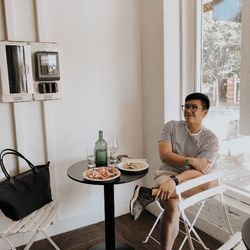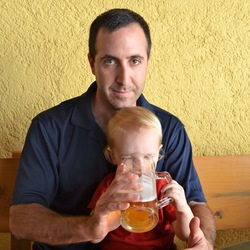Château Mondot
Château Troplong Mondot
Saint-Émilion 1er Grand Cru Classe Red Bordeaux Blend 2012
Other day. I only recall liking it very much. — 8 months ago
Château Smith Haut Lafitte
Le Petit Haut Lafitte Red Bordeaux Blend 2018
Again, not a wine that passed the drinkability test for me, but there are things that I liked about it, and some that I didn't. Right off the bat, it was way too heavy for me, both on the nose and palate. Heaps of oak aromas covering some sweet black fruits. The palate also came off as being quite sweet, almost syrupy, but here's where the balancing act comes in - just the right amount of acidity to keep it juicy. It's like biting into a very sweet, ripe, juicy plum with a peppering of cinnamon and vanilla. I enjoyed the tannins most, fine and directional, starting at the tip of the tongue, then swinging under before traveling down the inner walls of the gum. What a cool structure! And then there's the underlying minerality with air, which was pleasantly surprising. The finish took a turn for the worse - medium, rich, and oaky, yet bitter with hints of scorched earth character which I dislike. Also quite warm. Generally, more finessed than the 2011 Troplong Mondot, but less stacked and more stumbling blocks. Has potential. — 4 years ago
Château Troplong Mondot
Un Amour de Mondot St. Émilion Red Bordeaux Blend 1990
Whoa, hedonistic bouquet. Creme de cassis, coconut creme, truffle. Soft and round. Incredible nose, but a little shy on the palate. Slightly past peak? Still my WOTN. 1990 vintage on 6/30/18 — 7 years ago

Chateau Trolong Mondot
St. Émilion Red Bordeaux Blend 1990
1990 vintage. Excellent mid-neck fill. Picture perfect cork with minimal saturation. Decanted and tasted after 10 minutes and 2.5 hours. Throwing respectable, powdery sed but not too much. The funk blew off all too quickly and treated to a fairly unified effort. Light-medium/medium body. Front and mid-palates were doing all the heavy lifting early with not much on the back end initially but things evened out over time. Impeccable specimen so hesitant to base drinkability on this specific offering. This one drinking at this range for another near-decade/decade. Other examples would likely slot in as showing best for another half-decade. 08.02.25. — 3 months ago
Clos Apalta
Valle de Apalta Red Blend 2016
Honestly, after the two massive Bordeaux’s, this was hard to palate. It’s an even bigger wine! Instantly stood out as being from the new world to me due to the fruit quality, which was sort of glossy when compared to the Bordeaux’s. On the nose, ripe black fruits, liquorice, vanilla, capsicum, mint, tobacco, and a whiff of volatile acidity. For me, the flavours on the palate seemed a little one dimensional when compared to the nose (just creamy cassis from start to end), but it may well have been just closed at the time of my tasting. Again, like the other big wines of the night, I enjoyed the tannin structure the most, which was quite distinct, starting at the edge of the tongue before enveloping the inner walls of the gums. The finish was warm and undeniably long, but it doesn’t compare to the length of the 11’ Troplong Mondot. A JS 99-pointer, but a no-no for me. Probably needs heaps of cellaring to be palatable for me, that is if the fruit doesn’t dry out first. — 4 years ago
Component Wine
La Pyramide Grand Vin De Bordeaux 2017
My review did not post previously for some reason. This is a very impressive wine. Even over several hours it was continuing to open up and show additional layers. I wish we had saved some for the following night but we couldn’t help but finish it! From a small lieu-dit on the right bank next to Pavie and Troplong-Mondot. I had specific thoughts last month but they will have to wait for the next bottle. But I HIGHLY recommend Component wines. Actually, I recommend anything by Michael Kennedy. He has a Napa and Bordeaux line, along with the newly announced Gagnon-Kennedy brand from historic Napa sources. Come along for the ride! — 5 years ago
Château Tour Saint-Christophe
Saint-Émilion Red Bordeaux Blend 2020
2020 vintage. Tasted over the course of 1.5 hours. Medium body. Darker fruits (similar to Troplong-Mondot but less structure) evident from the get go. Plenty of upfront and mid-palate grip with things softening a bit in the later going. Picked up two bottles from Costco...seem to remember it retailing somewhere between $26-$33 a bottle. Definitely worth that pricing and beyond but this specimen wasn't hitting the high score/notes suggested by the Neal Martin review or Delectable others on this particular vintage. Maybe my palate was blown out by the previous wine...a 2019 Barolo. Perhaps. Will likely roll back and pick up two more bottles just to have laying around since it was drinking nicely anyway for the price. Was unfamiliar with this producer and a bit more "practice" won't hurt. 11.26.24. — a year ago











Stefan Dolhain
2016 vintage. Still a powerful wine, but much more finesse compared to the highly extracted wines from the nineties. — 24 days ago